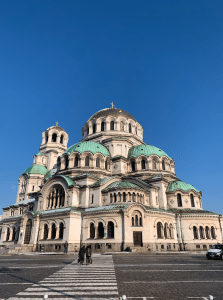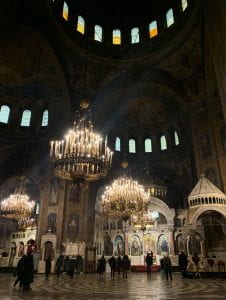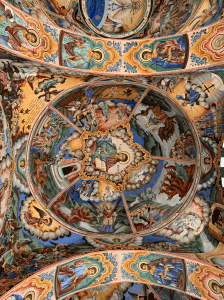Friday, March 18, 2022 | Written by Claire
Sofia, the capital of Bulgaria and home to one of Europe’s most ancient civilizations, is a stark contrast to the bustling Western European cities I’ve frequented in the past. Marred with Roman ruins and statues of Soviet figures, the city center has two sides: one lined with run-down buildings and tiny bakery shops while the other side is packed with luxury brands and high-end bars and clubs. The difference is staggering, and when I first stepped off the metro in-route to our hotel, I was taken aback. Old, crumbling buildings covered in graffiti, signs scrawled with Cyrillic, and quiet, empty streets paired well with the greying skies, casting a depressed look upon the city. But, as I continued to walk and observe the people, the food, and the overall culture in Bulgaria, I realized I was very far from the truth.
 Bulgaria was a place with very rich history and deep national pride. Their cultural norms were rooted for centuries, passed down from family and family. And one of the first influences I noticed was the presence of Eastern Orthodox churches and mosques. Located in the heart of Sofia is St. Alexander’s Basilica. Its brutal architecture featured green and golden domes with large, arched windows. Its intricate, rounded façade creates an encompassing sage haven, unlike the Western Catholic Churches that featured pointed roofs and arches that reached higher and higher into the heavens.
Bulgaria was a place with very rich history and deep national pride. Their cultural norms were rooted for centuries, passed down from family and family. And one of the first influences I noticed was the presence of Eastern Orthodox churches and mosques. Located in the heart of Sofia is St. Alexander’s Basilica. Its brutal architecture featured green and golden domes with large, arched windows. Its intricate, rounded façade creates an encompassing sage haven, unlike the Western Catholic Churches that featured pointed roofs and arches that reached higher and higher into the heavens.
 Inside, the atmosphere was even more unique. As we slowly entered, many Bulgarians would bow at the entrance and before the cross while performing the traditional Catholic crossbody hand gestures. The Basilica itself was very dimly lit with giant chandeliers that hung lowly from the ceiling. Paintings along the walls had darker undertones, featuring a more gothic approach than the fresh rococo style seen in Spain or Italy. There was a priest standing at the front of the sanctuary reading script in worship. His low, melodic yet monotone voice sent shivers down my spine. It was unlike anything I’ve seen or heard before.
Inside, the atmosphere was even more unique. As we slowly entered, many Bulgarians would bow at the entrance and before the cross while performing the traditional Catholic crossbody hand gestures. The Basilica itself was very dimly lit with giant chandeliers that hung lowly from the ceiling. Paintings along the walls had darker undertones, featuring a more gothic approach than the fresh rococo style seen in Spain or Italy. There was a priest standing at the front of the sanctuary reading script in worship. His low, melodic yet monotone voice sent shivers down my spine. It was unlike anything I’ve seen or heard before.
While St. Alexander’s Basilica was a perfect representation of one of the more traditional Eastern Orthodox churches in Bulgaria, we caught a train 3 hours away from the city center to the snow-covered tips of Ria’s Monastery. Here, the history runs even further back, almost all the way to 1200 BC. Paintings here were vibrant, even after so many years, and they featured works of thousands of artists and disciples year after year, adding on to other artists’ work. Breakaways in the stone walls revealed even older paintings, now faded, and discolored from years past, uncovering a web of biblical stories and depictions. The monastery was active, with 9 monks still living there. While the architecture outside was a major contrast to the classy basilica, its black and white stripes revealed its Ottoman influence. With the snowy peaks in the background, we trudged through the icy weather deeper up the mountain.  Three hours later, after a long hike with our feet freezing and noses running, we found ourselves back in Sofia sitting in a giant barrel in an empty restaurant. Thanks to my friend, Deni, who is Bulgarian, she recommended this traditional Bulgarian restaurant where folks would come to dance and drink in the evenings. It is often the site of celebration and lively musical performances where people would wear traditional Bulgarian dresses and outfits. While we didn’t get to witness the scene, we were still able to try heaping plates of Bulgarian salad, chicken, and sausage for just 3 euros per person, or 9 Bulgarian levees. The food itself was fantastic. Tender, flavored, and juicy, the sausages and Kofte patties were some of the best I’ve ever tasted. It was filled with a variety of herbs and other seasoning like cumin or other strong Asian spices.
Three hours later, after a long hike with our feet freezing and noses running, we found ourselves back in Sofia sitting in a giant barrel in an empty restaurant. Thanks to my friend, Deni, who is Bulgarian, she recommended this traditional Bulgarian restaurant where folks would come to dance and drink in the evenings. It is often the site of celebration and lively musical performances where people would wear traditional Bulgarian dresses and outfits. While we didn’t get to witness the scene, we were still able to try heaping plates of Bulgarian salad, chicken, and sausage for just 3 euros per person, or 9 Bulgarian levees. The food itself was fantastic. Tender, flavored, and juicy, the sausages and Kofte patties were some of the best I’ve ever tasted. It was filled with a variety of herbs and other seasoning like cumin or other strong Asian spices.
Overall, while our trip was short with long travel times, visiting Bulgaria was a very eye opening experience. It was indeed one of my favorite trips during my time at GTL so far, and simply walking around, learning some Cyrillic, and trying local foods, I was able to have a rich, immersive experience while refreshing my Eastern European history with local tours and first hand experiences. The people there are such generous people, not to mention their beautiful culture as well. While we had so much good food and great experiences I want to write about, these are just a few highlights from my trip. To check out a more in-depth follow through of my journey in Sofia, check out my Youtube channel: Claire Lin.
